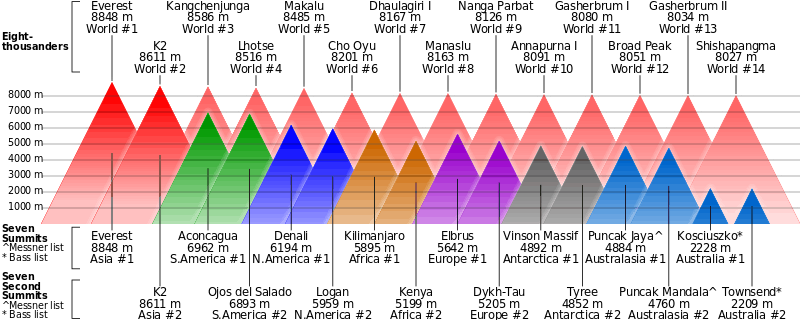Seven Summits
The Seven Summits are the highest mountains of each of the seven continents. Climbing to the summit of all of them is regarded as a mountaineering challenge, first achieved on 30 April 1985 by Richard Bass. Completing the Seven Summits and additionally reaching the north and south poles has been dubbed the Explorers Grand Slam.[1]
.svg.png)
Definition
The Seven Summits are composed of each of the highest mountain peaks of each of the seven continents. Different lists include slight variations, but generally the same core is maintained. The seven summits depend on the definition used for a continent – in particular the location of the border of that continent. This results in two points of variation: the first is Mont Blanc versus Mount Elbrus for the continent of Europe; and the second depends on whether one includes all of Oceania or only mainland Australia as the continent, which results in either Puncak Jaya (also known as "Carstensz Pyramid") or Mount Kosciuszko, respectively. This also gives rise to another list called "Eight Summits" including both Puncak Jaya and Mount Kosciuszko and the rest of the six summits in the other continents.
This creates several possible versions of the seven summits:
- Everest, Aconcagua, Denali, Kilimanjaro, Vinson, Elbrus, Puncak Jaya (the Messner version)
- Everest, Aconcagua, Denali, Kilimanjaro, Vinson, Elbrus, Kosciuszko (the Bass version)[2]
- Everest, Aconcagua, Denali, Kilimanjaro, Vinson, Mont Blanc, Kosciuszko (the 1950s explorer Hackett version)
- Everest, Aconcagua, Denali, Kilimanjaro, Vinson, Mont Blanc, Puncak Jaya
- Everest, Aconcagua, Denali, Kilimanjaro, Vinson, Mont Blanc, Mount Wilhelm (Wilhelm version)
The concept Richard Bass and his climbing partner Frank Wells were pursuing was to be the first to stand atop the highest mountain on each continent.[3] They pursued this goal as they defined it, climbing Aconcagua for South America, McKinley (now Denali) for North America, Kilimanjaro for Africa, Elbrus for Europe, Vinson for Antarctica, Kosciuszko for Australia, and finally Everest for Asia.[3]
Definition using tectonic plates
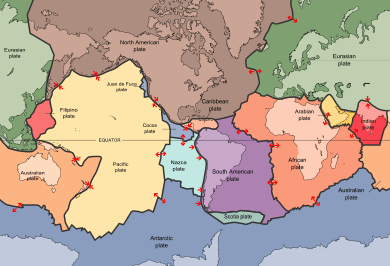
Using the largest tectonic plates, Europe and Asia could be grouped as Eurasia, and the very large Pacific plate would have Mauna Kea as its highest mountain.[4] Puncak Jaya is actually on the Maoke Plate, which is usually grouped with the larger Australian plate. If not, then Mount Kosciuszko would likely revert to being the highest of that plate (see also Australasia).
- African Plate – Kilimanjaro
- Antarctic Plate – Vinson
- Australian Plate – Puncak Jaya / Kosciuszko
- Eurasian Plate – Mount Everest
- North American Plate – Denali
- Pacific Plate – Mauna Kea
- South American Plate – Aconcagua
Australia
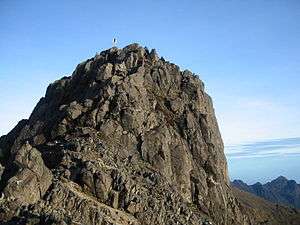
The highest mountain on the Australian mainland is Mount Kosciuszko, 2,228 metres (7,310 ft) above sea level. However, the highest mountain in the Australian continent which includes Australia and Papua is Puncak Jaya, 4,884 m (16,024 ft) above sea level,[lower-alpha 1] in the Indonesian province of Papua on the island of Papua, which lies on the Australian continental shelf. Mount Kosciuszko is very easy to climb, being a four hour, grade 3 return walk from the nearest car park, while Puncak Jaya is classed as a mountaineering expedition.
Some sources claim Mount Wilhelm (4,509 m (14,793 ft)) in Papua New Guinea's Bismarck Range as the highest mountain in Australia, on account of Indonesia being part of Asia.[5] (See List of Southeast Asian mountains, which includes Puncak Jaya and other mountains in Papua, Indonesia.) However, such a definition is political, not geophysical, and would mean that Papua changed continents in 1969.
In terms of Australia as a country, Mawson Peak (2,745 m (9,006 ft)) is higher than Kosciuszko; however, it is not located in Oceania, but on Heard island, a small island territory in the southern Indian Ocean. If excluding the island of New Guinea, then Aoraki / Mount Cook in the South Island of New Zealand is the highest mountain in Australasia at 3,724 m (12,218 ft).
Sources that list Mount Wilhelm as the Oceania high point or show boundaries putting Puncak Jaya in Asia include: The United Nations,[6] 7 Continent Summits,[7] World Atlas,[8] The CIA World Factbook,[9] Canada Atlas,[10] and Papua New Guinea PNG Trekking.[11]
Europe
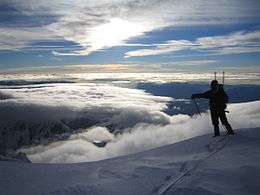
The generally accepted highest summit in Europe is Mount Elbrus (5,642 m or 18,510 ft) in the Caucasus, appearing on both the Bass and Messner lists. However, because the location of the boundary between Asia and Europe is not universally agreed upon, its inclusion in Europe is disputed: if the Kuma–Manych Depression is used as the geological border between Asia and Europe, the Caucasus and Elbrus lie wholly in Asia. If the Greater Caucasus watershed is used instead, Elbrus' peaks are wholly in Europe, albeit close to the border with Asia. Mont Blanc (4,810 m or 15,781 ft), lying on the border between France and Italy in the Graian Alps, is seen by some to be the highest mountain in Europe.[12]
Americas

North and South America have Denali and Aconcagua, respectively. Looking again at plate tectonics, there is also the possibility of summiting the high points on the smaller plates.[4]
- North America – Denali
- South America – Aconcagua
- Panama Plate – Cerro Chirripó (3,819 m or 12,530 ft)
- Caribbean Plate – Acatenango Volcano (3,976 m or 13,045 ft)[14]
- North Andes Plate – Chimborazo (6,263 m or 20,548 ft)
- Altiplano Plate – probably Nevado Sajama (6,542 m or 21,463 ft)
The Bass and Messner lists
The first Seven Summits list as postulated by Bass (the Bass or Kosciusko list) chose the highest mountain of mainland Australia, Mount Kosciuszko (2,228 m or 7,310 ft), to represent the Australian continent's highest summit. Reinhold Messner postulated another list (the Messner or Carstensz list), replacing Mount Kosciuszko with Indonesia's Puncak Jaya, or Carstensz Pyramid (4,884 m or 16,024 ft). Neither the Bass nor the Messner list includes Mont Blanc. From a mountaineering point of view, the Messner list is the more challenging one. Climbing Carstensz Pyramid has the character of an expedition, whereas the ascent of Kosciuszko is an easy hike. Indeed, Patrick Morrow used this argument to defend his choice to adhere to the Messner list, "Being a climber first and a collector second, I felt strongly that Carstensz Pyramid, the highest mountain in Australasia ... was a true mountaineer’s objective."[15]
| Image | Peak | Bass list | Messner list | Elevation | Prominence | Continent | Mountain Range | Country | First ascent |
|---|---|---|---|---|---|---|---|---|---|
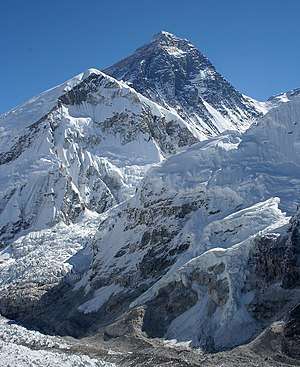 |
Mount Everest | ✔ | ✔ | 8,848 m (29,029 ft) | 8,848 m (29,029 ft) | Asia | Himalaya | Nepal / China | 1953 |
| Aconcagua | ✔ | ✔ | 6,961 m (22,838 ft) | 6,961 m (22,838 ft) | South America | Andes | Argentina | 1897 | |
 |
Denali | ✔ | ✔ | 6,194 m (20,322 ft) | 6,144 m (20,157 ft) | North America | Alaska Range | United States | 1913 |
| Kilimanjaro | ✔ | ✔ | 5,895 m (19,341 ft) | 5,885 m (19,308 ft) | Africa | – | Tanzania | 1889 | |
| Mount Elbrus | ✔ | ✔ | 5,642 m (18,510 ft) | 4,741 m (15,554 ft) | Europe | Caucasus Mountains | Russia | 1874 | |
.jpg) |
Mount Vinson | ✔ | ✔ | 4,892 m (16,050 ft) | 4,892 m (16,050 ft) | Antarctica | Sentinel Range | – | 1966 |
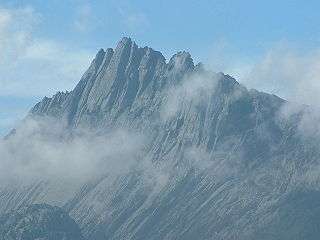 |
Puncak Jaya | ✔ | 4,884 m (16,024 ft) | 4,884 m (16,024 ft) | Australia | Sudirman Range | Indonesia | 1962 | |
| Mount Kosciuszko | ✔ | 2,228 m (7,310 ft) | 2,228 m (7,310 ft) | Australia | Great Dividing Range | Australia | Unknown |
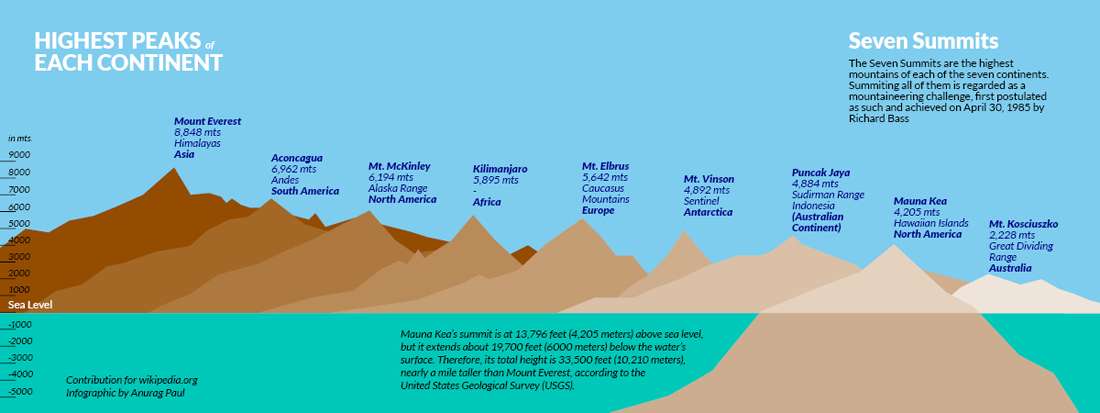
Mountaineering challenge
The mountaineering challenge to climb the Seven Summits is traditionally based on either the Bass or the Messner list. (It is assumed that most of the mountaineers who have completed the Seven Summits would have climbed Mont Blanc as well.) As of January 2010, approximately 275 climbers climbed all seven of the peaks from either the Bass or the Messner list; about 30% of those have climbed all of the eight peaks required to complete both lists.
History

In 1956, William D. Hackett (1918–1999), an American mountaineer, reached the top of five continents. He climbed Denali (1947), Aconcagua (1949), Kilimanjaro (1950), Kosciuszko (1956) and Mont Blanc (1956). In that time, Mont Blanc was considered to be the highest mountain of the European continent. Hackett made an attempt to climb Mt. Vinson and obtained a permit for Mt. Everest in 1960, but due to several circumstances (frostbite, lack of funds, etc.), he never made it to more than five summits.[16][17][18]
In 1970, the Japanese mountaineer and adventurer Naomi Uemura (1941-1984) was the first person to reach five of the Seven Summits including Mount Everest. He climbed Mont Blanc (1966), Kilimanjaro (1966), Aconcagua (1968), Mount Everest (1970 solo) and Denali (1970 solo). After the first solo trip to the North Pole (1978), he planned to go on his own to Antarctica to climb Mount Vinson. In preparation for the Antarctica expedition, he did a solo winter ascent of Denali (1984). On the descent he disappeared in a winter storm.[17][19]
In 1978, the Italian mountaineer Reinhold Messner was the first person to reach six of the Seven Summits (1971 Puncak Jaya, 1974 Aconcagua, 1976 Mt. McKinley (now Denali), 1978 Kilimanjaro, 1978 Mt. Everest). For Messner, Carstensz Pyramid (Puncak Jaya) was the highest peak in Australia (Messner list), but in 1983, he climbed Mt. Kosciuszko to also satisfy the other geographic definition of Australia. In the same year, Messner climbed Mt. Elbrus and declared that this is the true highest peak of Europe. This definition was quickly accepted by others in the mountaineering community. Finally in 1986, he climbed Mt. Vinson. At that time, he was only the fifth person to reach the Seven Summits.[17]
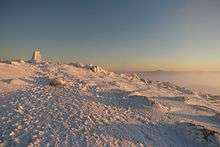
In 1985, Richard Bass, a businessman and amateur mountaineer, was the first man to climb all Seven Summits. In only one year, 1983, he climbed six peaks: Aconcagua, Denali, Kilimanjaro, Mt. Elbrus, Mt. Vinson and Mt. Kosciuszko. All of these climbs he did together with his companion Frank Wells and different mountain guides. Beginning in 1983, Bass and Wells made various guided attempts to climb Mt. Everest, the highest and most difficult peak in the list. On 30 April 1985, Bass reached the summit of Mt. Everest in a party without Wells, guided by the American professional mountaineer David Breashears. He then co-authored the book Seven Summits, which covered the undertaking.[20][17] Later in 1985, American mountaineer Gerry Roach became the second person to climb the Seven Summits.[21]
In 1986, the Canadian mountaineer Patrick Morrow became the first man to climb the Seven Summits in the Carstensz version (Messner list). He climbed Denali (1977), Aconcagua (1981), Mt. Everest (1982), Kilimanjaro (1983), Mt. Kosciuszko (1983), Mt. Vinson (1985), Mt. Elbrus (1985) and finally the Puncak Jaya (Carstensz Pyramid) on May 7, 1986. Morrow was also the first to complete both lists (Bass and Messner).[17][22]
In 1990, Rob Hall and Gary Ball became the first to complete the "Seven Summits" in seven months. Using the Bass list, they started with Everest on 10 May 1990, and finished with Vinson on 12 December 1990, hours before the seven-month deadline.[23]
In 1992, Junko Tabei became the first woman to complete the "Seven Summits".[24] Mary "Dolly" Lefever became the first American woman to climb the "Seven Summits" on March 11, 1993, when she climbed Australia's Mount Kosciuszko.[25][26] Earlier in 1993, she had become the oldest surviving woman to have reached the summit of Mt. Everest; she was 47 years old.[25] In January 1996, Chris Haver became the first American to climb and ski all seven summits.[27] Yasuko Namba was famous in her native Japan for becoming the second Japanese woman to reach all of the Seven Summits including Everest, where she died during the storm of May 1996 during her descent.[28]
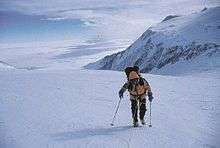
In 2000, Croatian mountaineer Stipe Božić completed the Seven Summits.[29] In May 2002, Susan Ershler and her husband, Phil, became the first married couple to climb the "Seven Summits" together.[30] The first person to complete Seven Summits without the use of supplemental oxygen on Mount Everest is Reinhold Messner.[31] Miroslav Caban is probably the second climber to finish the project without supplemental oxygen on Everest (finished in 2005 with Carstensz). Ed Viesturs also summitted all peaks without supplemental oxygen.[32] Between 2002 and 2007, Austrian climber Christian Stangl completed the Seven Summits (Messner list), climbing alone and without supplemental oxygen, and reported a record total ascent time from respective base camp to summit of 58 hours and 45 minutes.[33][34]
On 17 May 2006, Rhys Jones became the youngest person to complete the Seven Summits (Bass list) at the age of exactly 20 years.[35][36] Notable climbers who had previously been the youngest to complete the Seven Summits include Rob Hall in 1990 and David Keaton in 1995. In May 2007, Samantha Larson completed the seven at the age of 18 years and 220 days (she is still the youngest woman to have climbed the Seven Summits). Johnny Strange finished climbing the summits at the age of 17 years and 161 days in June 2009.[37][38] On 26 May 2011, at 6:45 Nepali time, Geordie Stewart became the youngest Briton to complete the Seven Summits at the age of 22 years and 21 days. In 2009-10, Indian mountaineer Krushnaa Patil made a bid for the fastest woman to complete the challenge; she fell short of the challenge when, in May 2009, her seventh and final summit bid on Denali was halted by her guide's illness.[39][40][41] George Atkinson then became the youngest person in the world to complete the round aged 16 years 362 days.[42][43] On 24 December 2011, the record was once again beaten, by American Jordan Romero, who completed the challenge at the age of 15 years, 5 months and 12 days by climbing Vinson.[44][45]
In October 2006, Kit Deslauriers became the first person to have skied down (parts of) all seven peaks (Bass list).[46] Three months later, in January 2007, Swedes Olof Sundström and Martin Letzter completed their Seven Summits skiing project by skiing down (parts of) Carstensz Pyramid, thus becoming the first and only people to have skied both lists.[47]
Indian mountaineer Malli Mastan Babu also had the eminence of setting a Guinness world record by surmounting the Seven Summits in 172 days in 2006.[48] The world record for completion of the Messner and Bass list was 136 days, by Danish climber Henrik Kristiansen in 2008. Kristiansen completed the summits in the following order: Vinson on Jan 21, Aconcagua on Feb 6, Kosciuszko on Feb 13, Kilimanjaro on Mar 1, Carstensz Pyramid on Mar 14, Elbrus on May 8, Everest on May 25, spending just 22 days on the mountain (normally, expeditions take up to two months acclimatizing, laying ropes, etc.) and finally Denali on June 5, beating Ian McKeever's previous record by 20 days.[49][50] Vern Tejas set the new record for the same, in 134 days. Tejas began with summiting Vinson on 18 January 2010 and ended with summiting Denali on May 31. This was Tejas' ninth time to complete the Bass Seven Summits.
[51] In January 2010, the Spanish climber Carlos Soria Fontán, at the age of 71, completed the seven summits (Messner list) after reaching the summit of Kilimanjaro. He had climbed the first one in 1968.[52] On 23 May 2010, AC Sherpa summited Mt. Everest as his last and final conquest of the Seven Summits (Bass list). In doing this, he set a new record by climbing the Seven Summits within 42 climbing days. Additionally, when climbing Mt. Kilimanjaro (via Marangu) he summited in just 16 hours and 37 minutes, easily beating the previous record of 18 hours.
As of 24 December 2011, it is reported that only 118 people have climbed the Seven Summits if one assumes "full" completion of the quest requires climbing the "Eight Summits" across both the Bass and Messner lists (climbing both Carstensz Pyramid and Kosciusko in addition to the other six "undisputed" summits such as Everest). 231 persons have climbed the Messner list, while 234 have completed the Bass list. 348 have done either the Bass or Messner list.[53]
In 2013, Vanessa O'Brien became the fastest female to complete the Seven Summits (including Carstensz Pyramid), finishing in 10 months.[54] Cason Crane became the first openly gay man to climb the Seven Summits.[55] On 21 November 2013, Werner Berger (Canada, ex-South African), at the age of 76 years and 129 days, became the oldest person in the world to complete the Seven Summits after a 6-day jungle trek to Carstensz Pyramid. In 2013, Cheryl and Nikki Bart became the first mother-daughter team to complete the Seven Summits.[56]
On 16 December 2014, Tashi and Nungshi Malik became the world's first twins and siblings to complete the Seven Summits (Messner list). Colin O'Brady broke the record for the Messner and Bass lists in 131 days, summiting Vinson on 17 January 2016 and completing with Denali on 27 May 2016.[57][58]
The youngest person to complete both the Seven Summits and the Volcanic Seven Summits is Daniel Bull from Australia. He completed the feat in 2017 at the age of 35.[59] He was also the first Australian to accomplish the feat.[60]
On 6 January 2018, Chris Bombardier reached the summit of Mount Vinson, becoming the first person with hemophilia to complete the Seven Summits (Messner list).[61] On 23 June 2018, Silvia Vasquez-Lavado reached the summit of Denali, becoming the first openly gay woman to complete the Seven Summits (including Carstensz Pyramid).[62]
Criticism
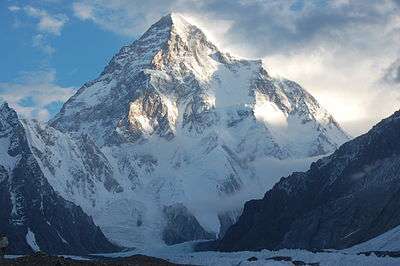
Alpinism author Jon Krakauer (1997) wrote in Into Thin Air[63] that it would be a bigger challenge to climb the second-highest peak of each continent, known as the Seven Second Summits – a feat that was not accomplished until January 2013. This discussion had previously been published in an article titled The Second Seven Summits in Rock & Ice Magazine (#77) authored by the mountaineer and Seven Summits completer David Keaton. This is especially true for Asia, as K2 (8,611 m) demands greater technical climbing skills than Everest (8,848 m), while altitude-related factors such as the thinness of the atmosphere, high winds and low temperatures remain much the same. Some of those completing the seven ascents are aware of the magnitude of the challenge. In 2000, in a foreword to Steve Bell et al., Seven Summits, Morrow opined "[t]he only reason Reinhold [Messner] wasn’t the first person to complete the seven was that he was too busy gambolling up the 14 tallest mountains in the world."[64]
Defence
Bill Allen, who completed the Seven Summits twice, said that getting to the summit never gets old.[65] The 8000ers are all in East Asia; Nepal, China, India and Pakistan in a more narrow region of Earth, and many of the climbs are quite dangerous with several climbers dying short of completing all 14.[66] Another problem is that while there are 14 main summits, there are additional sub-peaks over 8000 m.[66] Indeed, in 2013, authorities were considering officially recognizing some additional peaks as 8000ers.[67]
Impact and related climbing list concepts

One idea is to climb shorter peaks rather than the highest such as with the Seven Second Summits and Seven Third Summits. The Explorers Grand Slam includes the Seven Summits and both poles. Like the number one list, the number two and three lists is subject to the Bass vs. Messner geophysical/political dichotomy.
- Number twos
- K2
- Ojos del Salado ("Eyes of Salt")
- Mount Logan
- Dykh-Tau ("Jagged Mount")
- Mount Kenya
- Mount Tyree
- Puncak Mandala (formerly "Juliana Peak")
- Mount Townsend
A Seven Second Summits collection was first achieved in January 2013 by Christian Stangl. It is considered to be a more difficult mountaineering challenge than the standard Seven Summits, even if the peaks are lower.[68]
See also
- Eight-thousander
- Explorers Grand Slam, also known as The Adventurers Grand Slam
- Extreme points of Earth
- Extremes on Earth
- List of highest mountains
- List of islands by highest point
- Lists of mountains (for other climbing lists)
- Seven Second Summits
- Seven Third Summits
- Three Poles Challenge
- Volcanic Seven Summits
Notes
- A higher elevation of 5,030 m (16,503 ft) still appears on some maps and sites, but is accepted by neither Indonesia nor the mountaineering community, nor is it supported by modern surveys. High resolution IFSAR data supplied by Intermap shows no cell higher than 4,863 m (15,955 ft). See also Australian Universities' Expedition (section 2, page 4).
References
- Clukey, Abigail (2019-06-05). "'The Summit Is Never The Goal': Why Climbers Pursue The 7 Summits". NPR. Retrieved 2019-07-22.
- "Climbing the Seven Summits". www.infoplease.com.
- "The Adventurer: Dick Bass' Many Summits". Forbes. 12 November 2003.
- Helman, Adam (2008). "Seven Summits: Defining the Continents". www.cohp.org.
- Statistical Yearbook of Croatia, 2007
- "United Nations Geospatial Information Section Web Site". www.un.org.
- "7 Continent Summits". 7 Continent Summits.
- "World Atlas / World Map / Atlas of the World Including Geography Facts and Flags". www.worldatlas.com.
- "East Asia/Southeast Asia :: Indonesia – The World Factbook". www.cia.gov.
- "Map" (JPG).
- "PNG trekking adventures | Battlefield Treks and Culture". www.pngtrekkingadventures.com.
- "The Seven Summits". 8000ers.com.
- "Highest, Tallest, and Closest to the Stars". Astronomy Picture of the Day. NASA. 25 February 2016.
- "Constraints from finite element modeling on the active tectonics ofnorthern Central America and the Middle America Trench" (PDF). pendientedemigracion.ucm.es. 2008.
- Hamill 2012, p. 284.
- American Alpine Journal: In Memoriam – William D. Hackett, 1918–1999 AAJ 2000, Volume 42, Issue 74, p. 435.
- abc-of-mountaineering.com "History of the Quest for the Seven Summits (2004)" Archived 2015-10-17 at the Wayback Machine Retrieved 2 January 2015.
- British Mountaineering Council: "60 years of Seven Summits peak bagging (29/08/2013)" by Lindsay Griffin, thebmc.co.uk, Retrieved 2 January 2015.
- Naomi Uemura, renowned Japanese adventurer" Archived 2015-01-08 at the Wayback Machine, nikon.com, Retrieved 2 January 2015.
- Bass, Wells & Ridgeway 1986.
- "About Gerry Roach". climb.mountains.com. Retrieved 2 November 2017.
After climbing Mount Everest in 1983, he went on to become the second person to climb the highest peak on each of the seven continents in 1985.
- Jahoda, Petr (2006). History of 7 Summits project – who was first?. carstenszpapua.com. Retrieved 24 March 2015.
- Krakauer 1997, pp. 44–45.
- Horn, Robert (29 April 1996). "No Mountain Too High For Her: Junko Tabei defied Japanese views of women to become an expert climber". Sports Illustrated.
- "Mary "Dolly" Lefever". EverestHistory.com. 1993-05-10. Retrieved 2013-06-04.
- Balf, Todd (May 2, 2004). "Mountaineering: One Per Continent". Outside. Retrieved 2013-06-04.
- Tharp, Mike (1996-01-29). "One Skier's Seven Summit Quest". U.S. News & World Report.
- Salkeld, Audrey (May 2, 1996). "Everest Quest". Nova Online.
- "Stipe Bozic". EverestHistory.com. Archived from the original on 14 September 2015. Retrieved 10 October 2015.
- "Ershlers First Couple to Climb the Seven Summits". International Mountain Guides.
- "History of Seven Summits". carstenszpapua.com.
- "Czech climber tops seven summits". The Prague Post.
- 58 Stunden, 45 Minuten Archived April 10, 2008, at the Wayback Machine, Süddeutsche Zeitung, 10 December 2007. (in German)
- Fastest Everest climber eats 3, 6000m peaks in 16 hours Archived 2008-08-12 at the Wayback Machine, MountEverest.net, 9 November 2006
- "Youngest ever mountaineer completes seven summit challenge". Retrieved 17 May 2006. Cite journal requires
|journal=(help) - "Rhys' Everest Adventure". BBC.co.uk. Retrieved 1 April 2008.
- Riddel, Brad (November 2009). "On Top of the World". Boys' Life: 7. Retrieved September 26, 2012.
- Pete, Thomas (June 9, 2009). "Malibu's Johnny Strange, 17, becomes youngest to bag Seven Summits". Los Angeles Times. Retrieved September 26, 2012.
- "Krushnaa Patil: Bio". 9 October 2014. Archived from the original on 2018-06-30. Retrieved 2019-01-29.
- "Supermom wins Seven Summit title".
- "After Everest, Krushnaa Patil sets sight on new peaks - Latest News & Updates at Daily News & Analysis". 8 March 2011.
- "Hampshire climber Geordie Stewart held record for two hours". BBC News. May 26, 2011.
- Dominiczak, Peter (2011-05-26). "Youngest Briton to scale world's top peaks – News – Evening Standard". Thisislondon.co.uk. Archived from the original on 2011-08-05.
- "California teen becomes youngest to climb 7 summits". Associated Press. December 24, 2011. Retrieved 2012-11-24.
- "Jordan Romero Climbs Mt. Vinson Massif: Calif. Teen Becomes Youngest To Climb 7 Summits". Huffington Post. December 24, 2011.
- "Kit Deslauriers Ski Mountaineering Highlights". Archived from the original on 2013-09-30.
- Letzter, Martin. "Se7en Summits". Se7en Summits.
- Lewis, Daniel (April 22, 2012). "Climb every mountain". The Sydney Morning Herald. Retrieved 26 October 2012.
- "7-SUMMITS.DK Expedition 2008". 7-summits.dk.
- "Canadian man climbs highest mountains on seven continents in 187 days". CBC. 2006-11-28. Archived from the original on 2012-05-26.
- "Behind-the-Scenes of Colin O'Brady's Record-Shattering Expedition". Men's Journal. Retrieved 2017-01-24.
- "Carlos Soria culmina las "Siete Cumbres" casi a los 71 años". Archived from the original on September 30, 2011.
- Harry Kikstra's 7Summits database at http://www.7summits.com
- "Boston's Vanessa O'Brien Completes 'Explorer's Grand Slam' in Record Time". Boston.com. April 2013.
- "Out100: Cason Crane". Out. November 7, 2013. Retrieved March 11, 2014.
- Ostrow, Ruth (28 March 2014). "Total Success: How Cheryl Bart's heights reveal great depths". The Australian. Retrieved 26 October 2018.
- "Setting an epic world record".
- Stulberg, Brad (2016-07-19). "How Did Colin O'Brady Shatter an Absolutely Insane Endurance and Adventure Record?". Outside Online. Retrieved 2017-01-24.
- Christian, Natasha (6 September 2018). "Who you'd need to beat to snag a Guinness World Record". The Australian.
- "The Unstoppabull Daniel Bull" (PDF). The Mordialloc Chronicle. March 2018.
- "Hemophiliac Chris Bombardier Becomes First Ever to Climb 'Seven Summits'". Hemophilia News Today. 2018-02-07. Retrieved 2018-08-26.
- Parris, Aer (2018-12-14). "Meet the First Openly Gay Woman to Complete the Seven Summits". REI Co-op Journal. Retrieved 2019-03-15.
- Krakauer 1997, p. 24.
- Morrow, Pat "Foreword" Archived October 12, 2012, at the Wayback Machine, Seven Summits. Retrieved 2012-03-03.
- Hiltz, Jonathan. "The Irony of Everest". Pique.
- "The Quest for all 14 8000 Meter Peaks Summits: 8000 meter peaks". www.everestnews.com.
- "No decision yet on "new" 8000ers – Himalayas – Adventure Sports". dw.com. Retrieved 19 March 2018.
- "Which is harder, the Second Seven Summits or the first one?". 8 February 2012.
Bibliography
- "Statistics, Facts & figures of all 7summiteers: Carstensz, Kosciuszko and combined lists". 7summits.com. Retrieved 2011-12-25. Updated until December 2011, 348 summiteers.
- Bell, Steve; Naar, Ronald; Groen, Nico (2000). Seven Summits. Mitchell Beazley. ISBN 90-246-0606-3.
- Bass, Dick; Wells, Frank; Ridgeway, Rick (1986). Seven Summits. Warner Books. ISBN 0-446-51312-1.CS1 maint: ref=harv (link)
- Alvarez-Gómez, José A.; Paul T. Meijer; José J. Martinaz; Ramón Capote 2008. "Constraints from finite element modelling on the active tectonics of northern Central America and the Middle America Trench" (pdf). Tectonics. American Geophysical Union. 27 (TC1008). Bibcode:2008Tecto..27.1008A. doi:10.1029/2007TC002162. Retrieved 2008-08-04.
- Hamill, Mike (2012). Climbing the Seven Summits: A Comprehensive Guide to the Continents' Highest Peaks. Seattle: The Mountaineers Books. ISBN 978-1-59485-648-8. Retrieved October 18, 2012.CS1 maint: ref=harv (link)
- Morrow, Patrick (1986). Beyond Everest – Quest For the Seven Summits. Camden House. ISBN 0-920656-46-3.
- Krakauer, Jon (1997). Into thin Air. Villard. ISBN 0-385-49208-1.CS1 maint: ref=harv (link)
- "The Seven Summits". 8000ers.com. Retrieved 2006-08-08.
- "Carstensz Pyramid, the Summit of Oceania". 7summits.com. Retrieved 2006-08-08.
